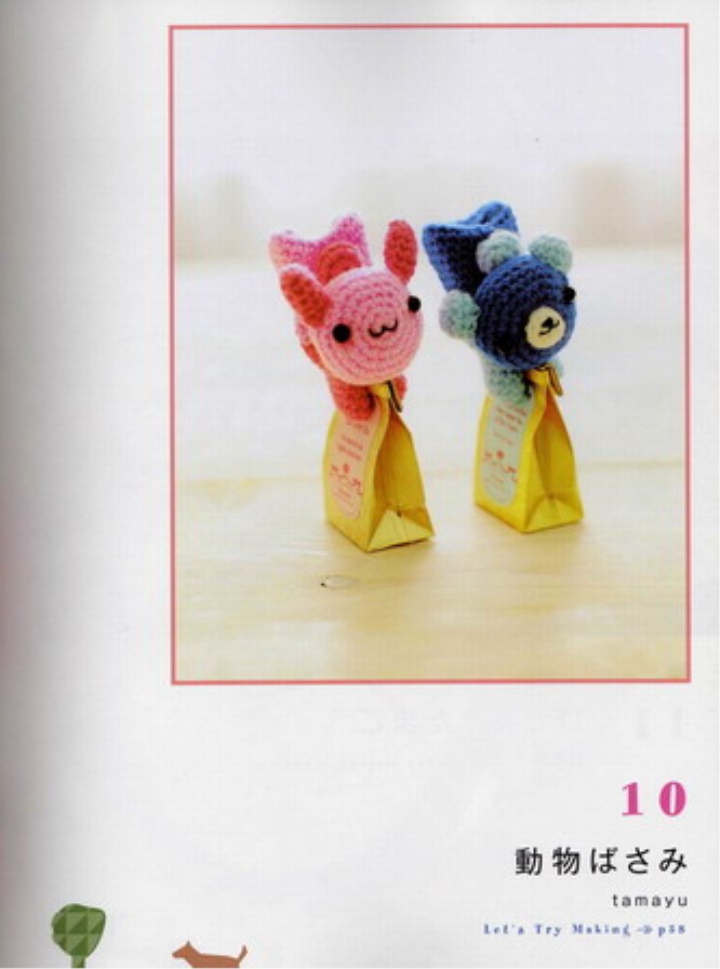
When I first started crocheting, this magazine about amigurumi was one of the first ones downloaded and studied with close attention. Part of the schemes caused only bewilderment - how can I tie such a thing?))) I had the impression that Japanese needlewomen go around the house with a crochet at the ready and are looking for - what else to tie around? The clothespins in the magazine looked very nice, but I had no idea which side to take on. Having gained some experience, I began to understand the principle of knitting, but did not want to try, because there were no ideas where to put these clothespins. Well, now there is a great opportunity to please loved ones)
In general, I will describe in detail the knitting of the main parts, and you will have to cope with the binding of the clothespins themselves, they are all different, you will have to carry out frequent fittings)
The principle is this: knit separately the front legs, head, ears and tail. Then we connect the legs and begin to knit the torso. And at the end we collect the head and fasten it and the tail to the body.
Materials and tools:
threads of different colors
hook, suitable to the thread (I have from 1.5 to 1.7)
clothespins
filler
eyes (I have self-adhesive with a movable pupil)
floss threads for embroidery muzzles
needle, scissors, glue
decorations for toys (optional)
Knit legs:
1st row: make amigurumi ring, recruit 6 loops (6)
2nd row: increase in each loop (12)
3rd row - 6th row: 12 sc (12)
My clothespins are small, with rather short legs, 6 rows were enough for me to finish the jumper. If you have other dimensions of clothespins, do a fitting and tie up rows as needed.
Knit head:
The head is standard everywhere, none of the animals had to change its size. The color of the yarn changed and the lion cub knit a couple of rows outside the box so that it had a projection around the head circumference that was tied with a mane.
1st row: make amigurumi ring, recruit 6 loops (6)
2nd row: increase in each loop (12)
3rd row: (1 sc, 1P) * 6 times (18)
4th row: (2 sc, 1P) * 6 times (24)
5th to 10th rows: (24 sc) (24)
11th row: (2 sc, 1u) * 6 times (18)
12th row: (1 sc, 1u) * 6 times (12)
You can knit a couple more drops, and you can just tighten the hole, not very tightly stuffed his head with filler.
A lion cub will have a head knitting pattern:
1st row: make amigurumi ring, recruit 6 loops (6)
2nd row: increase in each loop (12)
3rd row: (1 sc, 1P) * 6 times (18)
4th row: (2 sc, 1P) * 6 times (24)
5th row: 24 sc (24)
6th row: 24 sc for the front wall of the loop (24)
7th row: 24 sc for the rear wall of the loop of the 5th row (24)
8th - 10th rows: (24 sc) (24)
11th row: (2 sc, 1u) * 6 times (18)
12th row: (1 sc, 1u) * 6 times (12)
On the head of the cub there is a scar, through which we knit the sequence:
(5 CCH in one loop, 1 sc) * 12 times. It turns out the mane)
Ears round:
1st row: make amigurumi ring, type 5 loops (5)
2nd row: increase in each loop (10)
3rd row: 10 sc (10)
(the head of the frog is connected in the same way as the ears are round, only the 4th row in which 10 sc are added)
Triangular ears:
1st row: make amigurumi ring, type 5 loops (5)
Further I will describe how the sequence of loops, I will not divide by rows:
1 scn, 1p, 1 scn, 1p, 1 scn, 1 n, 1 scn, 1 n, 6 scn.
Ears long:
1st row: make amigurumi ring, type 5 loops (5)
2nd row: increase in each loop (10)
3rd row: (4 sc, 1P) * 2 times (12)
4th to 5th rows: (12 sc) (12)
6th row: (2 sc, 1y) * 3 times (9)
Tail round:
1st row: make amigurumi ring, type 5 loops (5)
2nd row: increase in each loop (10)
3rd row: 10 sc (10)
4th row: (1 sc, 1u) * 3 times (7)
The tail is long:
We pick up the chain from the VP (choose the length yourself) and knit in the opposite direction of the RLS, starting from the second loop from the hook.
From these elements, collect your little animals as a puzzle)))
I have as an example a pink hare. Here are the legs, tail and head: